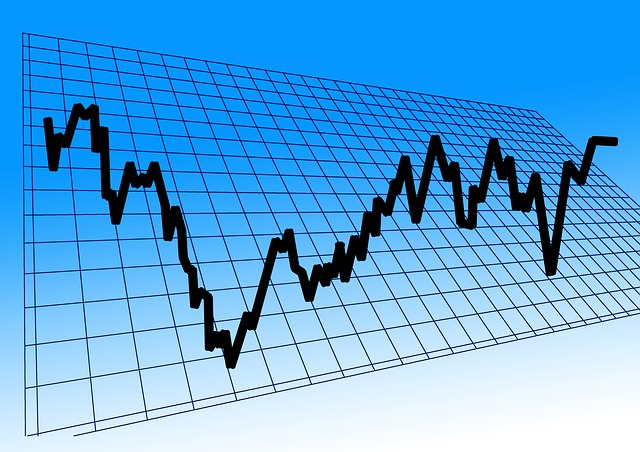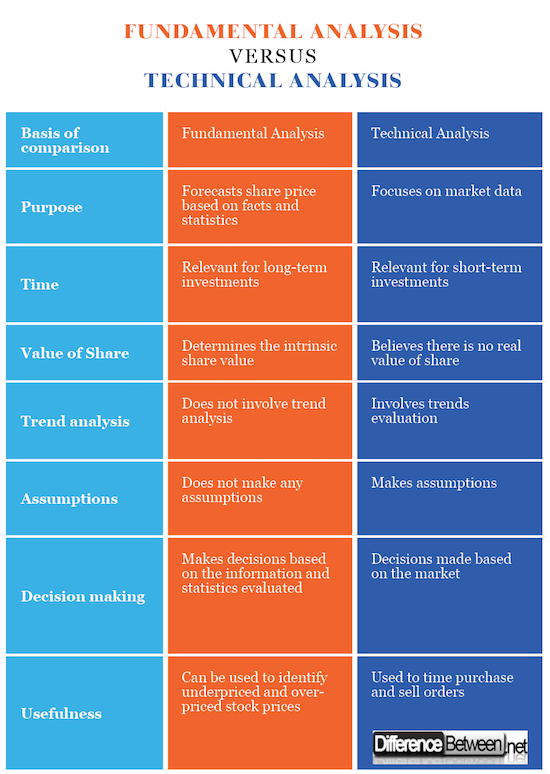Difference Between Technical and Fundamental Analysis
Both Technical and Fundamental analysis are techniques used by investors globally to make stock related decisions. They are however different in several ways; fundamental analysis seeks to determine the intrinsic value of stocks using relevant data while fundamental analysis uses the historic market activities and trends to predict future price expectations.
What is Fundamental Analysis?
This technique can be used to analyze several trading instruments including shares, indices, currency rate and commodities. It uses fundamental data such as the country’s GDP, employment rate, profitability rate of the company and medical related factors of the subject region.
When trading shares, fundamental analysis can be applied to evaluate certain factors such as the performance of a company, news and environmental conditions. A good example would be an investor who wants to determine whether he or she should purchase shares from company XYZ which is in the airline transport industry. Factors such as current and future expected oil price, political stability and tourism rate would form the fundamental concepts to be analyzed.
What is Technical Analysis?
Technical analysts are the individuals who believe the price charts contain all the information needed to make an investment decision. They believe that all the content of a specific asset is reflected in the price trends. They use price charts, trends, patterns and mathematical chart indicators to guide them through the investment decisions. It applies mostly to short-term trading cycles. The reason behind this is that traders who seek short term results are looking for minimal movements over short periods of time.
Differences between Fundamental Analysis and Technical Analysis
1. Purpose of Fundamental and Technical Analysis
The purpose of fundamental analysis is to forecast share prices based on economic, industry and the company statistics and facts. Despite this, the most important variables used in making these stock decisions are the earnings and dividend rate, the retained earnings ratio also plays a key role. Technical Analysis mostly focuses on the internal market statistics and data.
2. Long-term & Short-term Price Movement in Fundamental and Technical Analysis
For long-term investments decisions it makes much more sense to use a fundamental analysis. A fundamentalist is that investor who invests in long term projects. Long term investors purchase stock with large dividend payouts and hold the stock for several years through fluctuations and market shifts before finally selling them.
Technical analysis only determines short term price changes and trends. A technician is that investor who only purchases stock on short term basis. They do not follow the process of buying and keeping stock for a couple of years. This type of investor pays more attention to the short term profits which is calculated by the realized price less the purchase cost plus the dividend paid.
3. Value of Share in Fundamental and Technical Analysis
A fundamental analysis as mentioned earlier makes and intrinsic value estimate of the shares and purchases are made once the market price is determined to be less than the intrinsic value. Sales are them made when the market price surpasses the intrinsic value this could take a couple of years.
Technical analysis follows the concept of there is no real value of stock, it is all dependent on the demand and supply market forces. These market forces are then governed by both rational and irrational factors.
4. Finding the trend in Fundamental and Technical Analysis
Fundamental analysis does not involve the process of finding out past price trends and the faced fluctuations. Technicians however, believe that past trends will be re-current and will probably occur again. In technical analysis charts and tools with trends are used to create conclusions on the price movements. Prices and patterns are scrutinized through the provided statistics using indicators such as moving averages, odd lots, pull or call ratios and Fibonacci levels.
5. Assumptions
No assumptions are made in fundamental analysis, however in technical techniques, assumptions such as similar price trends and so much more are made.
6. Decision Making in Fundamental and Technical Analysis
The fundamental technique analyses financial statements, forecasts, management quality and the earnings and growth trends. They then make judgements related to the pricing based on subjective opinions from the available information and statistics. Technical analysts pay attention to the market trends to find out what it has to say. The market’s opinion is crucial and important in forecasting stock prices and making investment decisions.
7. Usefulness of Fundamental and Technical Analysis
Fundamental analysis is useful in identifying undervalued or overprices stocks. This is because it compares the intrinsic value and the market price. An intrinsic value is the real value of a stock price tabulated after full consideration of all business aspects including both the tangible and intangible features. Technical analysis is useful in the process of timing a purchase or sell order.
Fundamental Analysis vs. Technical Analysis: Comparison Table
Summary of Fundamental vs Technical Analysis
- Both fundamental and technical analysis are useful in making investment decisions.
- Investors who use fundamental analysis techniques are known as fundamentalists while those that use technical analysis are known as technicians or technical analysts.
- The two strategies can be applied in different situations and can be used alternatively depending on whether the investment plan is long-term or short-term.
- Fundamental analysis determines the intrinsic value of a share price and can be used to identify the under-valued or over-priced stocks in the market.
- Difference Between S Corp and C Corp - September 9, 2018
- Difference Between Terrace and Balcony - September 9, 2018
- Difference Between Anabaptists and Evangelicals - August 31, 2018
Search DifferenceBetween.net :
4 Comments
Leave a Response
References :
[0]Xie, Xin. Full View Integrated Technical Analysis: A Systematic Approach to Active Stock Market Investing. John Wiley & Sons, 2011.
[1]Schwager, Jack D. A Complete Guide to the Futures Market: Technical Analysis, Trading Systems, Fundamental Analysis, Options, Spreads, and Trading Principles. John Wiley & Sons, 2017.
[2]Krantz, Matt. Fundamental Analysis For Dummies. John Wiley & Sons, 2009.
[3]Bulkowski, Thomas N. Fundamental Analysis and Position Trading: Evolution of a Trader. John Wiley & Sons, 2012.
[4]Image credit: https://pixabay.com/en/success-curve-hand-finger-touch-1093892/
[5]Image credit: https://pixabay.com/en/stock-exchange-trading-floor-680583/




A very good guide to gain knowledge about the share market. The difference between technical & fundamental analysis is differentiated very well. Thanks for sharing such a good knowledge.
NIWS’s vision is to achieve our mission by implementing ethical and unimpeachable global market practices. NIWS will always work towards creating a pool of pre-eminent resources which can not only rein the Indian Financial market space but also find a place in the sun globally. Always, the best of upright principles and self – regulative measures are as important to the market response and balance as are the ordinances. Following our Vision, we feel that the benefits for our end-client must take precession over the importance of all other bourses, stakeholders, partners and members.
The article is very nice and provide good knowledge about the share market.
Thanks For Giving Us the difference between technical and fundamental analysis that will help lots of people so keep posting like this and there is website like sharetradingcampus.com it will also help you for alerts and for market ideas